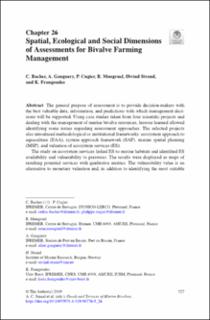| dc.description.abstract | The general purpose of assessment is to provide decision-makers with the best valuable data, information, and predictions with which management decisions will be supported. Using case studies taken from four scientific projects and dealing with the management of marine bivalve resources, lessons learned allowed identifying some issues regarding assessment approaches. The selected projects also introduced methodological or institutional frameworks: ecosystem approach to aquaculture (EAA), system approach framework (SAF), marine spatial planning (MSP), and valuation of ecosystem services (ES).
The study on ecosystem services linked ES to marine habitats and identified ES availability and vulnerability to pressures. The results were displayed as maps of resulting potential services with qualitative metrics. The vulnerability value is an alternative to monetary valuation and, in addition to identifying the most suitable areas for each type of ES, this metric allows identifying the management strategies that will most probably maintain or affect each individual ES.
The MSP example focused on bivalve farming activity and accounted for several criteria: habitat suitability, growth performance, environmental and regulation constraints and presence of other activities. The ultimate endpoint of such an approach is a map with qualitative values stating whether a location is suitable or not, depending on the weight given to each criterion.
In the EAA case study, the indicator was defined by the growth performance of cultivated bivalves in different locations. This indicator is affected by distant factors – e.g. populations of marine organisms competing for the same food resource, nutrient inputs from rivers, time to renew water bodies under the action of tidal currents. The role and interactions of these factors were assessed with a dynamical ecosystem model.
Examples illustrate that the assessment is often multi-dimensional, and that multiple variables would interact and affect the response to management options. Therefore, the existence of trade-offs, the definition of the appropriate spatial scale and resolution, the temporal dynamics and the distant effects of factors are keys to a policy-relevant assessment. EA and SAF examples show the interest of developing models relating response to input variables and testing scenarios. Dynamic models would be preferred when the relationship between input and output variables may be masked by non-linear effects, delay of responses or differences of scales.
When decision-making requires economic methods, monetary values are often of poor significance, especially for those ecosystem services whose loss could mean the end of life, and appear to be a comfortable oversimplification of reality of socio-ecological systems which cannot be summarized in single numbers. Alternative methods, such as the ones proposed in the SAF and ES examples, would preferably consider institutional analysis or multicriteria assessment rather than single monetary values.
Case studies also highlighted that credibility of assessment tools benefit from the association of stakeholders at different stages, among which: identification of the most critical policy issues; definition of system characteristics including ecological, economical and regulation dimensions; definition of modelling scenarios to sort out the most effective management options; assessment of models and indicators outputs. | en_US |
